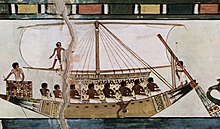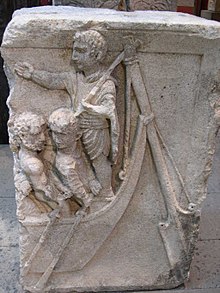Rudder - Simple English Wikipedia, the free encyclopedia



A rudder is used to steer ships, boats, submarines, aircraft, hovercraft or other vehicles that move through air or water.
History of the rudder[change | change source]
Oars mounted on the side of ships for steering are documented from the 3rd millennium BC in Persia and Ancient Egypt in artwork, wooden models, and even parts of actual boats of that times. An early example of an oar mounted on the stern is found in the Egyptian tomb of Menna (1422-1411 BC).[1] Stern-mounted oars were also quite common in Roman river navigation as proved from reliefs more than a millennium later.
A depiction of a sternpost-mounted rudder can be seen on a pottery model of a Chinese junk dating from the 1st century AD during the Han Dynasty, predating their appearance in the West by a thousand years.[2][3] The technology of stern-mounted rudder in Europe and Islam World, which was introduced by travelers in the Middle Ages, was transferred from China
Foot notes[change | change source]
- ↑ William F. Edgerton 1927. Ancient Egyptian Steering Gear. American Journal of Semitic Languages and Literatures 43, (4), 255.
- ↑ Tom, K.S. 198). Echoes from Old China: Life, Legends, and Lore of the Middle Kingdom. Honolulu: The Hawaii Chinese History Center of the University of Hawaii Press. ISBN 0-8248-1285-9. Page 103–104.
- ↑ Needham, Joseph. (1986). Science and Civilization in China: Volume 4, Physics and Physical Technology, Part 3, Civil Engineering and Nautics. Taipei: Caves Books Ltd. Pages 627–628.
Literature[change | change source]
- Lawrence V. Mott, The Development of the Rudder, A.D. 100-1600: A Technological Tale, Thesis May 1991, Texas A&M University
- Needham, Joseph (1986). Science and Civilization in China: Volume 4, Physics and Physical Technology, Part 3, Civil Engineering and Nautics. Taipei: Caves Books Ltd.


 French
French Deutsch
Deutsch